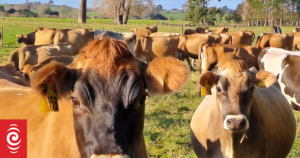
In the midst of challenges facing the dairy sector, Rabobank’s senior agricultural analyst, Emma Higgins, provides a nuanced perspective, countering notions of a “super-cycle downturn.” Reflecting on the past dairy downturn of 2014/15 and 2015/16, Higgins draws attention to the stark drop in milk prices from $8.40/kgMS to $4.40/kgMS over two years – a comparable scenario today would involve a decline from approximately $10.60/kgMS to $5.50/kgMS, adjusted for inflation.
Fonterra’s recent revision of its forecast milk price range to $6.25/kgMS – $7.75/kgMS has stirred discussions. Higgins highlights that the recent Global Dairy Trade (GDT) auction has pushed dairy commodity prices below their 5-year averages, indicating a significant adjustment that has been unfolding since Q2 of the previous year. She acknowledges the painful process of adaptation that industry stakeholders are currently experiencing.
Simultaneously, farmers are grappling with escalating costs, with a noticeable 13% year-on-year (YOY) increase. Notably, the farm price expense index for Q1 2023 demonstrates a YOY rise of 13% in all input costs, propelled by a 50% surge in interest rates, along with elevations in fertilizer (+11% YOY), dairy shed expenses (+11% YOY), and insurance premiums (+9% YOY). Against this backdrop, Fonterra’s farmgate forecast midpoint has dipped by 11% YOY.
Amid these challenges, Higgins identifies glimmers of optimism in terms of pricing dynamics. She sheds light on evolving factors influencing a rebalance within China’s dairy market, such as shifting milk prices, cost pressures, and a deceleration in farm expansion. However, she notes that uncertainties persist due to weakened demand settings, despite China’s gradual reopening.
Beyond China, RaboResearch’s analysis highlights diminished inventory levels in global dairy markets – a stark contrast to the previous downturn. Unlike the prolonged pressure on dairy commodity prices, particularly skim milk powder (SMP), caused by EU intervention stocks in the past, this time presents a different landscape. Additionally, the supply outlook is comparatively restrained, attributed to factors ranging from cost pressures in the US to weather-related challenges in parts of the EU. Looking ahead, potential risks like El Niño further underscore the challenge of sustaining milk supply growth in major exporting regions.
In essence, while the dairy sector confronts headwinds, Emma Higgins’ insights provide a balanced perspective, dispelling notions of an imminent “super-cycle downturn.” Instead, the industry is navigating through a complex web of factors, both domestically and globally, that require astute management and strategic adaptation to ensure its resilience and growth.







